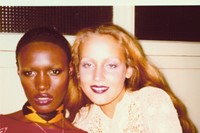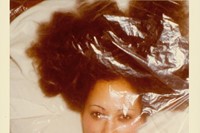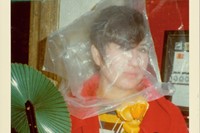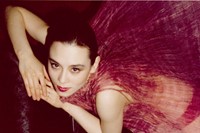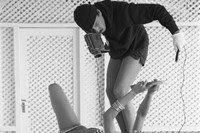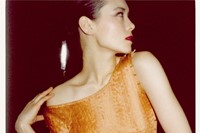We discover a lesser-known facet of Antonio Lopez's work: the hundreds of beguiling polaroids that he took, documenting (and exposing) the beautiful and unusual muses featured in his drawings
Antonio Lopez, more often referred to as simply Antonio, was one of the great fashion reactionaries of the 1970s and 80s, his much sought-after illustrations gracing the pages of all major fashion publications of the time, from Vogue to Interview, and perfectly embodying the mood, energy, sexuality and style of the disco era. But a lesser-known facet of his work is the hundreds of beguiling polaroids that he took, documenting (and exposing) the beautiful and unusual muses featured in his drawings. Many of these were women discovered by Antonio himself who, like his friend and contemporary Andy Warhol, had a shrewd eye for potential talent – think Jerry Hall, Grace Jones, Jessica Lange and Tina Chow.
A brilliantly curated selection of these images can be seen in a new book by Roger and Mauricio Padilha, entitled Antonio Lopez: Fashion, Art, Sex & Disco, which, along with the wonderfully enlightening text, provides great insight into Antonio's relationship with his muses, as well as his pivotal role in fashion's sexual revolution during the 70s (clearly demonstrated in the hugely sensual, at times masochistic, photographs). Here we speak to the Padilha brothers about their discovery of the polaroids, Antonio's nightlife and the enduring shock factor of his kinkiest works...
Do you remember when you first encountered Antonio’s work and the impact it had on you?
Roger Padilha: In the 70s and early 80s, it was impossible to be interested in fashion and not know who Antonio was. He was one of the most famous people in the industry. Fashion in the 70s was YSL, Halston, Fiorucci, and Antonio. Our first memory of his work was seeing his shopping bag designs for Bloomingdales on a shopping trip with our mother in Garden City, Long Island. We saved that bag (and still have it!) and then started seeing the same signature to illustrations in Vogue.
How did you first become involved in this project?
Mauricio Padilha: After our book on Stephen Sprouse, we were really searching for a subject that we felt had the same quality of being under-appreciated yet still was influencing the world today. Also, when you write a book, you tend to figuratively get "married" to a subject for 2 years so if you don't love a subject to begin with, then it gets hard to finish a book. So we thought, "Who would we want to spend the next 2 years with 24/7?" and Antonio was someone we knew we wouldn't get tired of.
"Antonio always knew the direction that fashion was going and I think the sexualising of his work was in part who he had become"
Antonio's polaroids are a relatively unexplored and unknown sector of his work. Where did you discover them?
RP: Paul Caranicas holds the Antonio archives so they were all there. It was amazing – literally hundreds and thousands of polaroids. We'd open one box and there would be stacks and stacks of Grace Jones polaroids, then we'd open another and there would be stacks of Jerry, then another with stacks of Karl Lagerfeld – it was overwhelming and amazing.
Do you have a favorite?
RP: Our favorites are in the book. I love the ones of Jerry and Grace smoking – they look so young and like they are just having fun with Antonio.
MP: I love the Tina Chow in Fortuny. She looks so beautiful.
The book talks about Antonio’s almost Warholian discovery of young muses who later went on to become huge in their own right. Could you tell us a bit about his social life, what drew him to certain women and where he would discover them?
RP: Antonio loved going out at night. After a long day of working, he would go to Max's Kansas City in NYC or the Club Sept in Paris and dance the night away. We heard from so many people that he was the most amazing and wild dancer. And it was here that he discovered many of his models. Antonio was really into extremes so if he was going to use a black model, he wanted the darkest model he could find like Grace or if he needed to find an American girl, he needed to find Jerry who was Texan with waist length blonde hair.
Which of his muses do you deduce to have had the biggest influence on Antonio?
MP: Actually it was quite the opposite. You can ask any of his models and they will say that Antonio was the biggest influence in their lives. He dressed them, taught them how to do their makeup, how to model, how to dress, and in some cases, like Tina Chow, even introduced them to their boyfriends and husbands.
What do you think were the motives behind Antonio's much more sexualised approach to his work in the 1970s?
RP: Antonio always knew the direction that fashion was going and I think the sexualising of his work was in part who he had become (by the 70s he was single and indulging in the free love that everyone else was) but it was also a huge trend in the 70s with Guy Bourdin, Helmut Newton, and Chris Van Wagenheim. Antonio however really pushed it and some of his works were so provocative that they could only be published in Playboy or Oui. They are still shocking today! When we do lectures on the book now, both of us blush and get flustered when we project some of those images up.
Antonio Lopez: Fashion, Art, Sex & Disco is published by Rizzoli and is available now.
Text by Daisy Woodward

